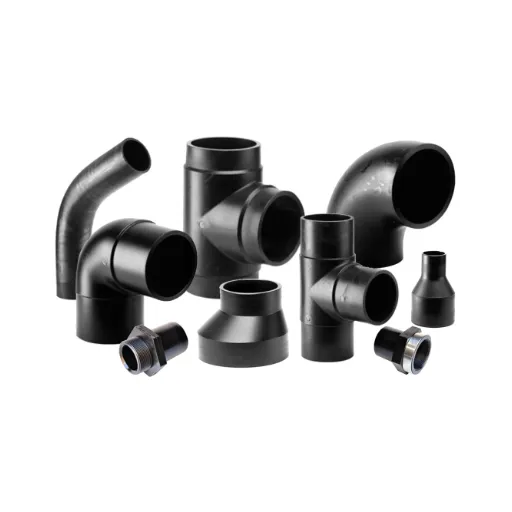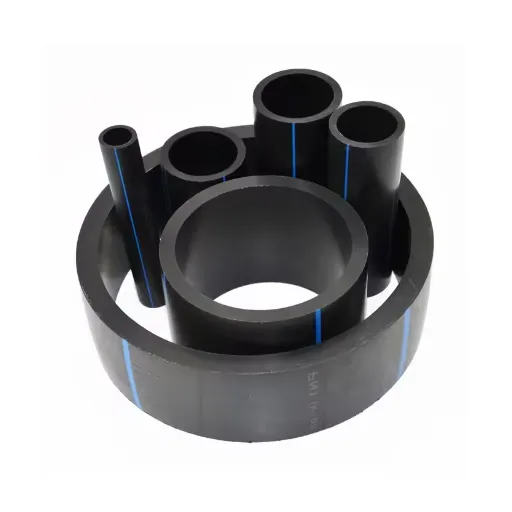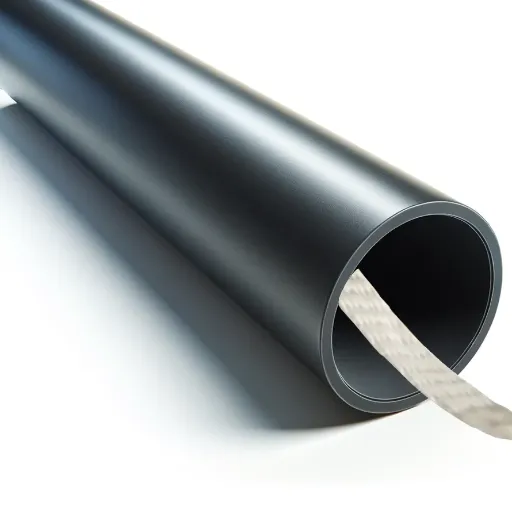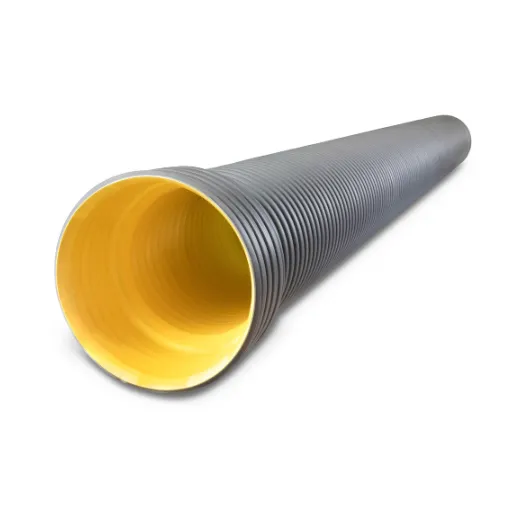Polyethylene (PE) and HDPE pipes have become essential elements in modern roads and infrastructural development across all industries. In water distribution, gas pipelines, or other industrial purposes, these PE and HDPE pipe fittings provide systems that can work with efficiency, durability, and in an eco-friendly manner. But what exactly makes these fitting different, and how can they be used to maximize performance for different ends? This article takes you into the world of PE and HDPE pipe fittings, their features, benefits, and applications, so that you can have a complete view of their necessity and flexibility. Thus, the article is sure to be helpful to an industry professional, engineer, or those curious about the technology; these fittings have become important to the world of modern piping solutions.
Introduction to PE Pipe Fittings

What are PE Pipe Fittings?
PE pipe fittings are used for connecting or joining, or changing the flow direction on PE pipe systems. Polyethylene is a very versatile thermoplastic, well-known for its durability, flexibility, and corrosion resistance. Such fittings are intended to serve any application requiring leak-proof connections, from water distribution to gas supply and industrial piping systems.
One important feature of PE pipe fittings is their compatibility with PE pipes that have similar properties. They offer excellent resistance against environmental stress cracking and chemical action. Hence, they are used in installations either above or below ground. These fittings are also light in weight and easy to handle, unlike metallic ones, which makes transportation and installation easy.
Different types and designs of PE fittings are available to include couplers, elbows, tees, reducers, and end caps. These variants allow a variety of system designs to achieve specific functional requirements. Also, welding techniques like butt fusion or electrofusion are usually employed to join them to pipes because such methods produce strong, permanent, and reliable connections that will require the very least amount of maintenance over time.
Advantages of Using Polyethylene Pipe
- Durability and Longevity: Polyethylene (PE) pipes have resistance against environmental stress cracking and corrosion and are thus used in long-term projects in severe applications. It is said to have a lifespan of more than 50 years under usual operating conditions and to have a higher life expectancy than any other traditional material.
- Flexibility and Versatility: The elasticity shown by PE pipes enables them to cope with slight ground movements from seismic or soil settling activities without cracking or breaking. This characteristic also aids in installation in difficult terrains, thus negating the need for complicated jointing systems.
- Leak-Free Connections: Fusion techniques such as butt or electrofusion provide completely fused and leak-proof joints. Industry research has indicated that fusion-welded joints in PE piping systems are established to be highly reliable with failure rates below 0.1 percent when properly installed.
- Chemical and Corrosion Resistance: Such pipes of PE are inert and resist a vast array of chemicals, making them ideal for piping corrosive fluids or in an environment that causes other materials to degrade. This resistance increases their functional life and significantly reduces maintenance costs.
- Cost-Effectiveness: PE pipes being light and hence easy and cheap to transport and install compared to other materials such as steel or even PVC. Moreover, they are cheap to maintain, which reduces the life cycle cost even further, making it quite attractive for large and high-profile projects that have a long life span.
Overview of HDPE Pipe and Its Benefits
High-Density Polyethylene (HDPE) pipe is a versatile piping material that finds numerous applications across industries due to its durability, flexibility, and low cost. It is manufactured from high-density polyethylene resin, thereby conferring the pipe superior mechanical properties against traditional materials like concrete, steel, or PVC. HDPE pipes stand up well to being applied in water supply, gas distribution, sewage, and industrial applications due to their ability to stand up to high pressure and harsh environmental conditions.
Primarily, HDPE pipes provide the highest level of resistance to corrosion and chemical action. Unlike steel or metallic piping systems that rust and degrade over time, HDPE pipes do not react to any abrasive or acidic material placed upon them; this resistance allows for all-around operational longevity as well as guaranteed performance through decades. Given their degree of flexibility, they can prove to be very good choices for use in seismic areas because the pipes can absorb movement without losing structural integrity.
HDPE pipes are low-priced solutions. Transportation and handling become reduced, as does on-site equipment requirement; project completion times are further reduced due to ease of installation, plus less manual labor cost is involved. They are cheaper to maintain and usually more cost-effective overall as the life of these pipes exceeds 50 years if maintained well. These inherent characteristics of strength and adaptability have made HDPE pipes a choice with obvious practical benefits in most modern infrastructure and engineering projects.
Types of PE Pipe Fittings
Common Types of HDPE Pipe Fittings
The HDPE pipe fittings exist in several design formats to be accommodated in several applications, demanding compatibility with several installation and operational factors. Most common HDPE pipe fittings and accessories include:
Elbows
Elbows, essentially, are directions changing directions in piping systems at either 45° or 90°. These pipes are used for all sorts of routing configurations in water distribution, gas conveyance, and industrial pipelines.
Tees
The process that creates the branch connection for flow to be split or merged between pipes is called a Tee. They come as equal and reducing to give flexibility in considering complex pipeline networks.
Reducers
Reducers connect pipes of different diameters to allow the change in diameter to be smooth while maintaining a high degree of efficiency in the system. These fittings are essential in those systems where the controlled manner of changes in flow capacity is necessary.
Couplers
Couplers join two lengths of piping, making them truly useful in extending the pipelines as part of installation works or for repair. They can join either through butt fusion, electrofusion, or mechanical means so as to give a stronger seal.
Flange Adapters
Flange adapters are considered as very versatile connectors between HDPE pipes and other materials or equipment, for example-steel valves. They will be designed to ensure structural integrity under pressure and hence indispensability in inter-material transitions.
End Caps
End caps help with closing down or sealing the flanges of HDPE pipes so that no leakage or contamination can take place. Especially useful in terminating a line whether temporarily or permanently.
Note: These fittings are made with modern technologies such as precision molding and are usually designed to meet standards such as ISO 4427 and ASTM D3261, to enhance their dependability. In industrial applications, HDPE pipe fittings are widely used for municipal water, oil, and gas and wastewater treatment, all of which appreciate the flexibility, corrosion resistance, and ability to be leak-free that this product offers.
Insert Fittings: Definition and Applications
Insert fittings belong to one category of pipe fittings designed to achieve secure and dependable connections in piping systems through barbed ends inserted into the pipe. These fittings are intended for use with flexible tubing such as polyethylene (PE) or polyvinyl chloride (PVC) pipes, with the barbing aiding in gripping the hose to resist disconnection. The simplicity of the design guarantees an easy installation, typically requiring just a clamp or a crimping tool to hold the connection securely.
Insert fittings find applications industrially whenever low-to-medium pressure is to be expected, which occurs in irrigation for agriculture, drip systems, potable water distribution, and sometimes chemical transferring. The insert fittings can resist a number of operational conditions due to their manufacture from high-grade materials like polypropylene, brass, or stainless steel that resist varying temperatures, corrosion, and chemicals. They are also available in several configurations, including couplings, tees, elbows, and adapters, giving them versatility in piping system layout according to actual needs.
For high-performance operations, it must be ensured that insert fittings are selected and rated in accordance with industry standards, such as ASTM F2098 or NSF certifications, to guarantee long-term reliability for the system under potable water or food-grade applications.
Comparing Polyethylene Pipe Fittings with Other Materials
Depending on the durability, cost, flexibility, corrosion resistance, and environmental impact, polyethylene pipe fittings are compared with other materials such as PVC, steel, copper, and concrete.
| Material | Durability | Cost | Flexibility | Corrosion | Eco-Friendly |
|---|---|---|---|---|---|
| Polyethylene | High | Low | High | Resistant | Recyclable |
| PVC | Moderate | Low | Moderate | Resistant | Partially |
| Steel | High | High | Low | Prone | Non-recyclable |
| Copper | High | High | Low | Resistant | Recyclable |
| Concrete | High | Moderate | Low | Prone | Non-recyclable |
Installation of PE Pipe Fittings
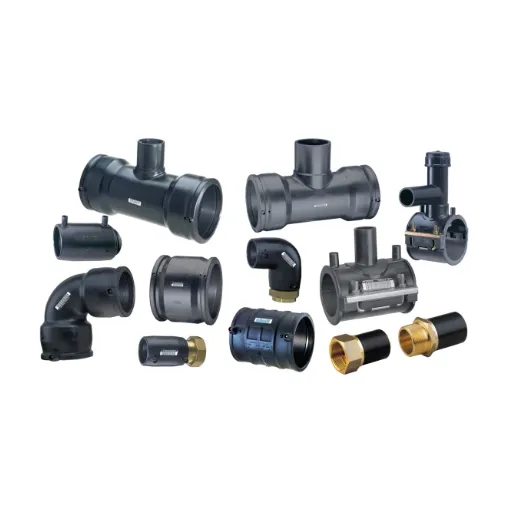
Step-by-Step Guide to Installing HDPE Pipe Fittings
High-Density Polyethylene (HDPE) pipe and fittings have become the mainstay in modern piping systems due to longevity, flexibility, and resistance to corrosion. A well-detailed guide has been laid out to walk one in the essentials of proper installation that promotes efficiency and performance.
-
1
Materials and Tools’ Preparation
Before installation, HDPE pipes and fittings must be checked/out for any visible damage or defects. Then, during installation, the requirements must include: pipe cutters, welding machines (for butt fusion or electrofusion), alignment clamps, and cleaning materials; ensure that they are all compatible and safe as per manufacturers’ guidelines.
-
2
Site Inspection and Pipe Layout
Inspect the location where the pipes are to be installed and corroborate the measurements according to the project design blueprint. Lay out pipes probably with reference to the plan for the trench or mounting points, aiming for minimal bends or obstructions.
-
3
Pipe Cutting and End Preparation
Cut pipes to lengths required with pipe cutters approved for HDPE pipes that provide smooth cuts with clean edges. Clean the pipe ends to get rid of any dirt or dust, or anything that can contaminate or obstruct the joining processes. Check for correct alignment to avoid any misalignment of pipes in welding.
-
4
Joining Method Selection
Butt Fusion: Performed in a fusion machine in which the ends of pipes are heated and welded together to form a continuous, seamless, and leak-proof joint. The alignment and heating should be effective for the best results.
Electrofusion: Uses fittings with a built-in resistance wire that heats the pipe and fitting as joint fillers. This method is suitable for tight locations or where precise jointing is essential.
-
5
Welding Process
Proceed with the welding process associated with the selected welding method. Ensure the pipe ends are heated to the butt fusion procedure specification, pressed mutually, and a bead is CARED and even all around is established. For electrofusion, ensure that the fitting is positioned correctly and apply the voltage and time as specified in the manufacturer’s instructions. Allow the joint to cool sufficiently.
-
6
Pressure Testing
Pressure testing will follow when the joints are completed to verify integrity and leak resistance through hydrostatic or pneumatic means. Test pressures are gradually raised to avoid sudden surges, and pressure drops are monitored as indicative signs of leaks.
-
7
Backfilling and Final Inspection
Upon completion of the test, backfill the trench with suitable material, compacting adequately around the pipe to prevent damage or displacement. Conduct a final inspection of the entire system to ensure that it complies with project specifications and standards.
Important: HDPE pipe installations following these guidelines can provide a reliable and long-term solution with minimal maintenance requirements and maximum operational performance. Taking care to comply with manufacturer recommendations as well as site-specific requirements guarantees installation and ensures compliance with applicable regulations.
Best Practices for Successful Installation
A few guidelines need to be considered when ensuring the installation of an HDPE pipe that’s strong and durable. Initiate a complete site appraisal to assess the hazards, soil conditions, and environmental factors that might affect the pipeline. Trench preparation should be proper; the trenches should have uniform depth and width so that the bedding is evenly done and there is less stress on the pipe. The bedding material should be the best granular material, capable of preventing pipe deformation and enhancing load distribution.
Fusion procedures such as butt, electrofusion, etc., should be carried out under utmost care so that the joints never leak and the pipeline never suffers any compromise in integrity. The methods described should be strictly kept within the recommended fusion parameters as provided by the manufacturer, i.e., temperature, pressure, and cooling time. Also, make sure to use the best-calibrated tools and fusion equipment so that the measurements and alignments are accurate.
Once completed, periodic inspection and, wherever possible, use of non-destructive testing (NDT) methods will identify potential weaknesses or variations, allowing for timely correction. Terrain monitoring can be implemented where applicable to monitor installation quality in real time against design specifications. Lastly, maintaining a full record for the entire installation process will assist in quality control and serve as a solid reference source when performing maintenance or audits in the future. By observing such procedures, HDPE pipelines and systems will attain their highest performance and long life.
Applications of PE Pipe Fittings
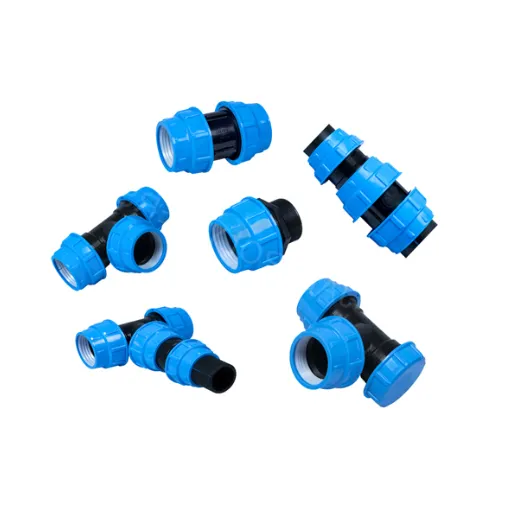
Use in Plumbing Systems
Polyethylene (PE) pipe fittings are the most common fittings utilized in plumbing systems for their good durability, flexibility, resistance to corrosion, etc. All these features make PE pipe fittings fit for application in all kinds of residential, commercial, and industrial plumbing systems. Enumerated below are five key applications of PE pipe fittings in plumbing-related work, accompanied by a little description of each:
- Water Supply Lines: PE pipe fittings are widely applied and found in water supply lines because the connection is somehow secure, leak-free, and safe. These fittings were capable of water distribution under low or very high pressure. The pipe can withstand pressure ratings up to 16 bar, which guarantees its reliability in potable water applications.
- Irrigation Systems: PE fittings serve the irrigation needs of agricultural and landscape projects because of their UV resistance and ability to withstand variable water pressure. Their flexible nature also permits installation on uneven terrains, reducing chances for cracking or leakage.
- Drainage Systems: In drainage, PE fittings cement a crucial position so far as the transportation of wastewater and stormwater is concerned. These fittings have the smoothest interior surface that minimizes deposits and ensures efficient water flow, and therefore, are ideally suited for drainage uses. The chemical resistance of such fittings ensures a long life in corrosive environments.
- Pipe Repair and Maintenance: PE fittings are very frequently used for repairs of damaged networks. Compression couplings and mechanical fittings ensure quick and effective restoration of leaking pipelines without shutting down large parts of the system. These types of fittings allow for thermal expansion in the pipeline and thus ensure a stable repair over time.
- Gas Distribution Systems: High-density polyethylene (HDPE) fittings are used in gas distribution networks in massive quantities thanks to their strength, resistance to corrosion, and low permeability. These fittings are suitable for pressures up to 10 bars, which makes them most suitable for conveying the gas safely and efficiently.
Due to the versatility and efficacy of PE pipe fittings, they are found to be one of the most attractive options in present-day plumbing systems; ensuring low-maintenance solutions across various applications which are durable.
Applications in Agriculture
Polyethylene pipe fittings have increasingly gained importance in agriculture for their property of durability and flexibility, and resistance to varying environmental conditions. Their role is pivotal in upgrading irrigation systems, reducing water wastage, and ensuring sustainable farming. The following are five major uses of PE pipe fittings in agriculture:
- Drip Irrigation Systems: In drip irrigation, these fittings find use in the precise delivery of water to the root zone of crops and hence guarantee irrigation efficiencies well beyond the conventional system, reducing water consumption by 30-50%.
- Sprinkler Systems: PE fittings for sprinkler systems guarantee an even water application over a large field. Their high-pressure ratings offer reliable performances in changing climate conditions with a minimum wastage of water.
- Fertigation Systems: Fertigation is the supplying of fertilizer dissolved in water through irrigation systems. PE pipe fittings are suitable for this purpose, which allows application of nutrients to ensure better crop yield and lesser wastage of fertilizers.
- Livestock Water Supply Networks: PE pipe fittings are utilized in developing strong and leak-proof networks for supplying water to the livestock. Their corrosion resistance and great longevity make them an ideal option for supplying them all over the countryside and agricultural setup clean and consistent water supply.
- Drainage Systems: HDPE fittings are used in drainage systems for agricultural applications to drain the excess water from the fields to keep the fields free. These systems contribute to efficient water removal, meaning good soil aeration and protection against crop damage through over-watering.
Through such versatile applications, PE pipe fittings change agricultural activities towards more productive and sustainable ones.
Role in Construction and Industrial Manufacturing
Polyethylene Pipe Fittings Technology for Well and Manufacturing Purposes in Construction. Their durability, cost-effectiveness, ease of installation-all these make them extremely useful for a wide array of applications. Here are five uses of PE pipe fittings in these industries:
- Water Supply Systems: PE fittings are used in municipal water supply systems and commercial water supply systems, respectively. They are corrosion-resistant, capable of resisting very high pressures for the water supply, and normally function in these capacities for a long time with very little maintenance. The study states that the PE pipes have over 50 years to perform in the field.
- Wastewater and Sewage Management: For their resistance to chemical degradation and their non-reactive behavior that diminishes blockages while heavy loads ensure efficient flow in the wastewater and sewage systems, they are considered important to those systems. It is evidenced that the introduction of PE fittings really reduced by 40% the maintenance needs of the system over traditional materials.
- Gas Distribution Networks: PE fittings serve helpfully in gas pipelines of residential and industrial distribution. Being light in weight, they permit quicker installation, whereas leak-proof design ensures maximum safety. Their performance is so good that almost 90% of natural gas distribution pipelines in many countries are made of PE materials.
- Cooling and Heating Systems: PE fittings have good performance in HVAC applications. They accommodate temperature fluctuations without cracking or leakage in energy-efficient systems. Test data reveals that a good quality of PE fittings will tolerate temperatures ranging from -40°F to 140°F without incurring any damage.
- Chemical Transport: Industry utilizes PE pipe fittings to transport corrosive chemicals safely. Their chemical resistance experiences no corrosion, and that in itself guarantees safety in a hazardous environment. According to studies, PE fittings can handle industrial chemicals, e.g., acids, bases, and salts, without compromising materials and being able to meet regulatory standards.
These applications clearly elucidate how PE pipe fittings provide construction and industrial systems with efficiency, reliability, and sustainability. Their variable nature continues to glow for many industries worldwide.
Emerging Trends and Innovations
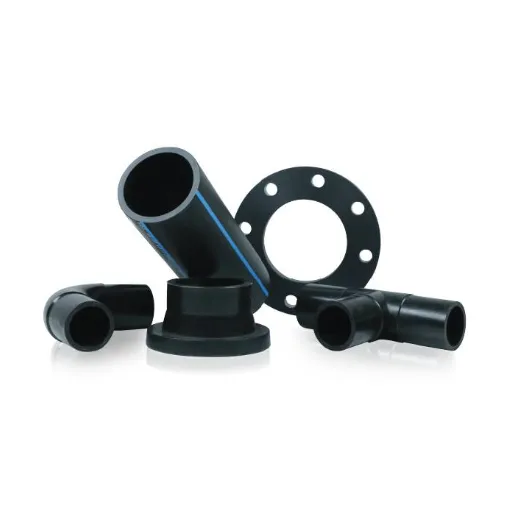
Advancements in HDPE Pipe Technology
In recent years, great strides have been made in HDPE pipe technology-the consequent improvements have brought with them enhanced performance, durability, and efficiency for varying applications. One such innovation relates to PE-100 RC (Resistant to Crack) materials, designed to provide enhanced resistance to slow crack growth and external damage and thus improve the pipeline lifecycle in harsh environments. Furthermore, multilayer HDPE pipes have been advancing, now combining structural layers with reinforcement to optimize strength yet lessen pipe weight-which allows operational and cost advantages.
The fusion welding processes, such as butt fusion and electrofusion, have undergone development, therefore permitting a stronger and more reliable weld or joint integrity. These have reduced the weak points of a system design and have enabled it to pass tough safety and performance regulations even under extreme conditions. Advances in digital monitoring techniques now allow real-time evaluation of HDPE pipeline status with respect to pressure, leak possibilities, and maintenance, thereby lowering the chances of operational downtimes.
Another trend lies in the development of bio-based HDPE materials, which go hand in hand with global sustainability aspirations. Contrary to conventional HDPE, these materials come from renewable sources while providing similar mechanical properties to conventional HDPE. With all these developments, it is safe to say that HDPE pipes stand in a prime position in modern infrastructure, with applications that fit the changing needs of industries around the world.
Sustainable Solutions in PE Pipe Fittings
When it comes to the discussion of environmentally sustainable measures for PE pipe fittings, I would emphasize innovations that do so without compromising functionality. One central approach to this is the integration of recycled polyethylene material as raw material in pipe-fitting manufacturing. By taking plastic waste, either post-consumer or post-industrial, manufacturers are considerably lessening their dependence on virgin raw materials and thereby lessening the environmental impact in terms of production. While addressing the plastic waste problem, this method also aids in promoting a circular economy in the pipeline industry.
More development in manufacturing technology, therefore, means that increasingly energy-efficient and less-waste-producing processes can be used. Energy-efficient methods such as low-energy molding and precision engineering ensure the best use of materials, thereby creating less scrap and consuming less energy, all in pursuit of sustainable manufacturing processes. Hence, these approaches fit very well within the industry’s overall pursuit of sustainability and offer great promise in cutting down carbon emissions from pipe fitting production.
Looking on a larger scale, bio-based polyethylene that is produced from renewable raw materials such as sugarcane opens up yet another sustainability aspect in PE pipe fittings. Bio-polyethylene is chemically equivalent to and possesses all the performance properties of a conventional polyethylene yet scores the green side because carbon gets sequestered at the stage of raw material growth. This establishes a strong background for the eventual switch to other materials that offer the required durability yet work towards active carbon neutrality on a global scale. By these developments, the industry showcases a mark of sustainability, ensuring that progress is not downscaled in terms of quality or assurance.
Future Trends in Polyethylene Pipe Applications
With the evolution of polyethylene (PE) piping systems in parallel with advances in material sciences and growing environmental concerns, one major trend is the blending of advanced polymers and additives to resist external stresses such as UV radiation, high temperature, and chemical corrosion. This essentially ensures that the service life of systems is prolonged even when exposed to harsh operating environments, thereby ensuring greater cost efficiency and reliability, especially where the infrastructure is critical.
Another area that is becoming a quite popular trend in PE pipe networks is smart monitoring. Embedded sensors with the ability to collect real-time data on flow rate, pressure, and potentially leaks are being developed for integration with IoT platforms to consider predictive maintenance. This, as a result, puts fault detection ahead of system failure and improves operational efficiency.
Polyethylene recycled for pipe manufacturing is another way in which circular economy concepts can be embraced to reduce the carbon footprint of the manufacturing process and to adhere to the considered stringent sustainability goals of governments and industry. With developments like PEX and HDPE, broadening application areas into green energy applications such as geothermal systems, the future of PE piping systems seems to be equally promising technically and ecologically.
Frequently Asked Questions (FAQ)
Q: What are PE pipe fittings?
A: PE pipe fittings are connectors that fit onto polyethylene pipes so that liquids or gases can flow through them. These fittings are made of high-density polyethylene (HDPE) and are available in various shapes and sizes for different applications.
Q: How does an electrofusion fitting work with PE pipes?
A: Electrofusion fittings apply current to melt the surface of the pipe and the fitting, joining them in a strong and permanent bond. Such a connection provides an excellent leak-proof joint that can guarantee safety in the distribution of water and gas.
Q: For what types of connections are polyethylene fittings used?
A: Polyethylene fittings provide several types of connections; they include butt fusion, electrofusion, and compression fittings. All these may serve different purposes depending on whether to join pipe sizes or various components inside heating systems.
Q: Can black palm pipe be compatible with various pipe sizes?
A: Yes, since black palm pipe is more competent and available in variable pipe sizes, it may be suitable for various applications. It is generally used in irrigation, water distribution, and heating systems by virtue of its durable nature and corrosion resistance.
Q: How important is the gasket in PE pipe fittings?
A: A gasket provides a seal between the two adjoining pipe fittings, thereby guaranteeing a leak-proof connection. Usually, when assembling high-density polyethylene pipes and fittings, these gaskets play a critical role in ensuring the system’s integrity remains intact and prevents any fluid loss.
Q: How is the burying of PE pipe fittings carried out?
A: Normally, when carrying out the burying of PE pipe fittings, consideration has to be given first to the depth and alignment. The fittings should be securely positioned at the end of the pipe, and the soil surrounding the fitting should be compacted to provide stability to prevent shifting.
Q: What is the function of nuts and bolts in handling fittings?
A: Nuts and bolts are occasionally used with certain types of pipe fittings to hold connections together and ensure tight sealing. They are very useful where mechanical fastening is desired to ensure system reliability.
Q: How does the coil form of polyethylene pipe aid in installation?
A: Easy handling and installation make the coil form of polyethylene pipe convenient, especially in big projects. The fewer joints mean fewer places for leaks to occur, which makes it an excellent choice for irrigation and drainage applications.
Q: What might I need to bear in mind when choosing polyethylene pipe fittings for heating systems?
A: Consider the temperature and pressure ratings of the heating system when selecting polyethylene pipe fittings. The fittings should be rated for the actual working conditions and be compatible with the method of connection involved in your application.
References
- Design Standard – Underground Piping Installations
This Texas A&M document stipulates design standards for underground piping installations, specifying requirements for PE pipes and fittings. - Polyethylene Pipes and Fittings
An academic paper that studies at length the nature and uses of polyethylene pipe and fittings. - Piping and Fittings – Building Maintenance and Construction
An instructional resource from Hawaii Open Educational Resources about the use of fittings in plumbing systems, including PE pipe fittings. - Poly Pipe Heat Fusion
A Matech Educational guide on heat fusion for thermoplastic pipes, including PE pipes.
Ready to Implement PE Pipe Fittings?
PE pipe fittings offer unmatched durability, flexibility, and cost-effectiveness for modern piping solutions across industries. Whether you’re planning a new installation or upgrading existing systems, these advanced materials provide reliable, long-term performance with minimal maintenance requirements.



